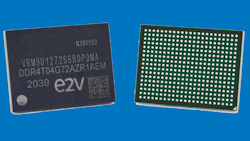High-density DDR4 modules provide more memory in smaller spaces. By extensive design and testing, Teledyne e2v has developed flight-worthy DDR4 memories that are radiation hardened and ready for space. The compact memory modules measure 15 × 20 × 1.92 mm but save on printed-circuit-board (PCB) space by packing 4 GBytes of storage capacity and achieving data transfer rates to 2.4 GT/s. The model DDR4T04G72 DDR4 is supplied in a multichip package (MCP) and assigns 64 bits to data transfer and an additional 8 bits for error correction (see the figure). The memory module is compatible with a wide range of microprocessors and field-programmable gate arrays (FPGAs) from Teledyne e2v and other suppliers.
The memories have been radiation tested to determine a single-event latch-up (SEL) level of better than 60 MeV-cm2/mg. Single-event upset (SEU) and single-event function-interrupt (SEFI) levels also exceed 60 MeV-cm2/mg. The devices have been shown suitability for computing and signal-processing applications in high-radiation environments, with the capability of withstanding total ionizing doses (TIDs) as high as 100 krad. The devices are available for industrial operating temperatures (-40 to +105°C) and military operating temperatures (-55 to +125°C).
Concerning the radiation-hardened (rad-hard) DDR4s and their value to the space industry, Thomas Guillemain, Marketing and Business Development Manager at Teledyne e2v, said: “We are recognized as leading the way in elevated density radiation tolerant memory for space applications, and our technology has already been incredibly well received by the market. What differentiates us from the competition is the comprehensive and open data package we provide, giving clients everything, they require to start their designs and complete them in the shortest possible timeframe, with all the background information and expert engineering support readily available.”
About the Author
Jack Browne
Technical Contributor
Jack Browne, Technical Contributor, has worked in technical publishing for over 30 years. He managed the content and production of three technical journals while at the American Institute of Physics, including Medical Physics and the Journal of Vacuum Science & Technology. He has been a Publisher and Editor for Penton Media, started the firm’s Wireless Symposium & Exhibition trade show in 1993, and currently serves as Technical Contributor for that company's Microwaves & RF magazine. Browne, who holds a BS in Mathematics from City College of New York and BA degrees in English and Philosophy from Fordham University, is a member of the IEEE.
